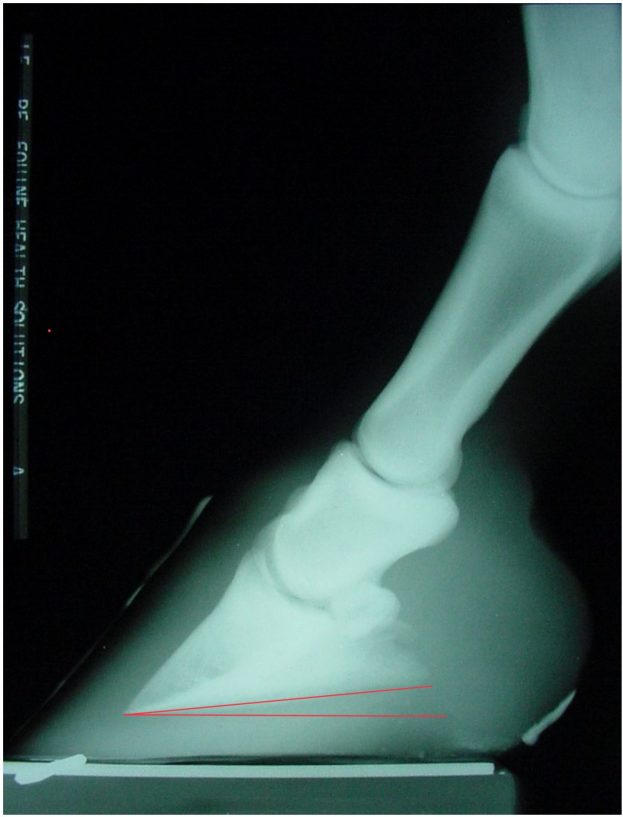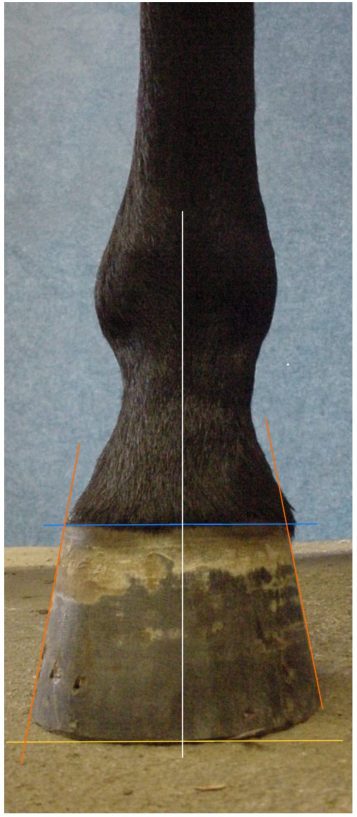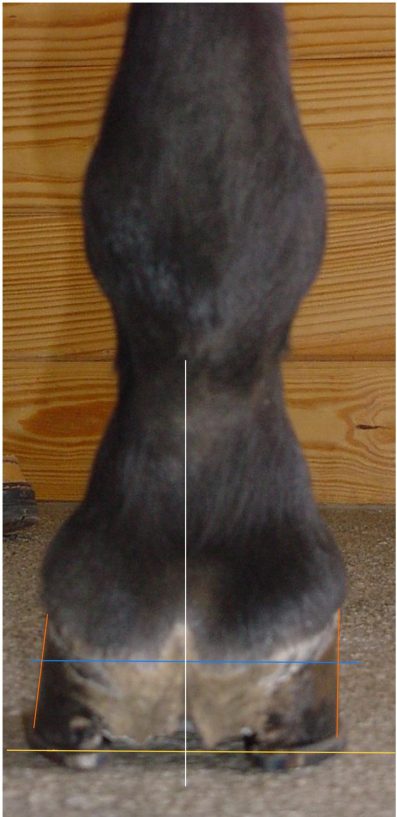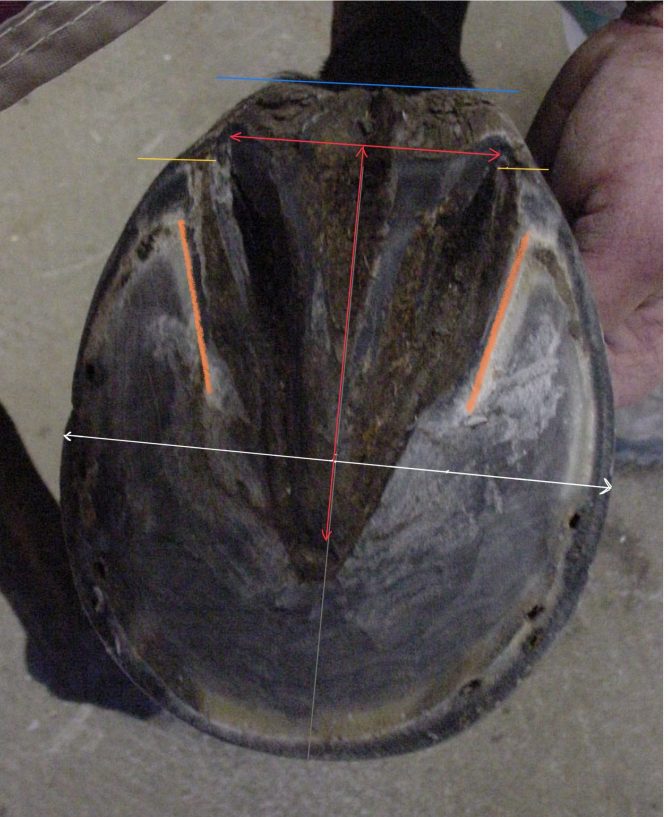The foot is very important to the overall health of the horse. Some people do not realize that the old saying “No Hoof No Horse” is very pertinent to their horse’s well-being. A good farrier doing a proper trim and shoeing is essential to your horse’s biomechanical movement and performance. Having someone who knows proper hoof conformation in the light of your horse’s overall conformation and trimming the hoof correctly with balance is required for your horse’s health.
This article will be the first of a two-part series in regards to hoof conformation and proper trimming requirements. We will discuss the desired parameters of a hoof trim and what should be accomplish to obtain a balance trimmed hoof conformation and biomechanics. Of course no horse has perfect conformation, so the best farrier work needs to be done with the parameters of the horse.
Balance is important in the function of the horse and their hooves. We us a static stance to determine balance and project the information gained into a movement balance. Ideally checking the hoof conformation for movement balance would be best. Smart phone camera and technology make this more readily available. With that in mind, the set of hoof conformational parameters we will discuss are anticipated to provide quality biomechanics and movement.

We will start by looking at the lower limb in a lateral or side view, as illustrated in the photo. Using the lateral view we can assess the toe angle or dorsal wall angle (white line), the heel angle (red line) and the coronet angle (blue line).
Toe angle or dorsal wall angle is the angle the dorsal wall makes with the ground. The line should follow the dorsal or front of the hoof connecting to the front or dorsal pastern. This line should be straight as illustrated. There should not be a break in the line at the coronet indicating the pastern and dorsal hoof wall have two different angles. The angle this line creates with the ground surface (yellow line) should be similar to the spine of scapula or shoulder angle. Depending on the horse’s boney structure, the dorsal hoof angle can be in the 53 – 56 degree range.
The heel angle (red line) which is the angle produced by the contact of the heel of the hoof (red line) with the ground surface (yellow line). This angle should be no more than 5 degrees different from the toe or dorsal wall angle. This ground contact angle allows the force of hoof/ground contact to be dispersed up the horn tubules of the hoof. With poor contact angle, hoof and leg problems can develop.

The coronet angle (blue line) should have a gentle angle falling from dorsal hoof wall to heel. The line should be straight with no rises or falls in the coronet. This is an indication of the palmer angle of the coffin bone. The palmer angle is the angle the sole surface of the coffin bone makes with the ground. This is depicted in the lines on the radiograph or x-ray photo.
The next view we will address is the front or dorsal view, as illustrated in the photo.

Assessing the coronet is the primary assessment in this view. The coronet (blue line) should be parallel with the ground (yellow line). In assessing this, ideally the white line should bisect the hoof and leg in half. Leg conformation will influence this evaluation. The medial and lateral hoof angles (orange line) should be similar. The point of intersection of the blue and orange lines should be the same distance from the ground surface. The length of the dorsal wall line (white line) should be in the 3” – 3.5” range depending on the weight of the horse.

The next view we will discuss is the palmer or heel view, as illustrated in the photo. The heel height (blue line) should be equal in distance from the ground (yellow line). The heels should have the same amount of mass to them. Also the height of the coronet where the orange lines intersect the hairline should be equal form side to side. Ideally the medial and lateral hoof angle (orange lines) should be similar. The dividing line between the heels should divide the middle sulcus of the frog.
The final view we will discuss is the sole or ground contact view photo. The widest part of the hoof (white line) should be the middle of the foot when measured from toe to heel (gray line). The heel height is the distance between the coronet (blue line) and heel/ground contact point (yellow line). The further the distance indicates more heel mass for shock absorption for the ground contact forces with ideal horn tubule ground contact angle. Also an indication of heel mass is the frog ratio. The frog ratio is the frog width divided by the frog length (red lines). The frog ratio should be greater than 66%. The frog should be trimmed to remove excess tissue and open up the frog sulcus. The bars (orange lines) should be trimmed level with the hoof wall so to enable ground contact and support during weight bearing.

If the horse is left barefooted, the hoof wall should be beveled. The bevel removes the outside half edge of the hoof wall thus reducing the hoof wall from cracking or breaking off. If the horse is shod the bevel is much less and the shoe is shaped to fit the hoof. The hoof should not be rasped to fit the shoe. The shoe should be wider than the hoof at the heels. The increase width of the shoe is such you should be able to stand a dime alongside the hoof on the exposed shoe. This allows the shoe to support the expanding hoof as it lands on the ground.
As the horse walks the hoof should land flat on the ground. If the toe or heel hits significantly before the other a vibration will be created in the leg. This vibration force can damage other anatomical structures of the leg. This can be assessed with a smart phone by videoing the horse at a walk from the side or lateral view. If you play the video at a slow speed, the contact of the hoof to the ground can be evaluated.
With this information you should be comfortable evaluating your horse’s feet and your farrier’s work with your horse’s feet. Having a balance hoof is important for the biomechanical movement of your horse. A properly trimmed and balance hoof is the foundation for skeletal balance and function. If we have imbalance in the hoof we are prone to having more chiropractic issues and lameness problems in the horse. Hopefully you feel comfortable with this information and hoof parameters to evaluate your horse’s feet. The second part of the series will deal with the hind hoof.
